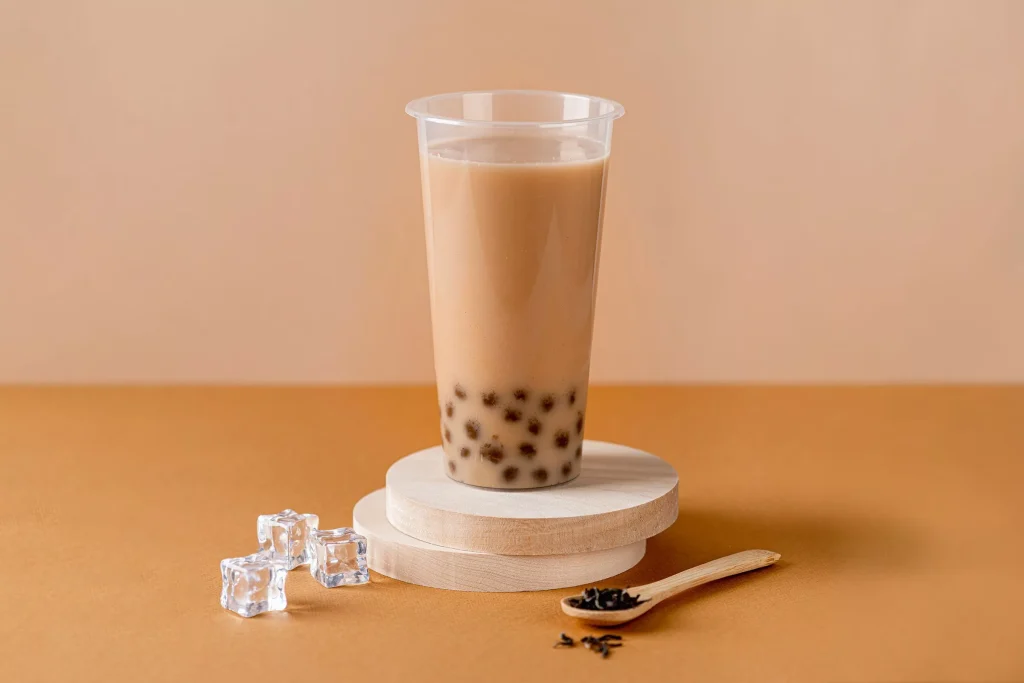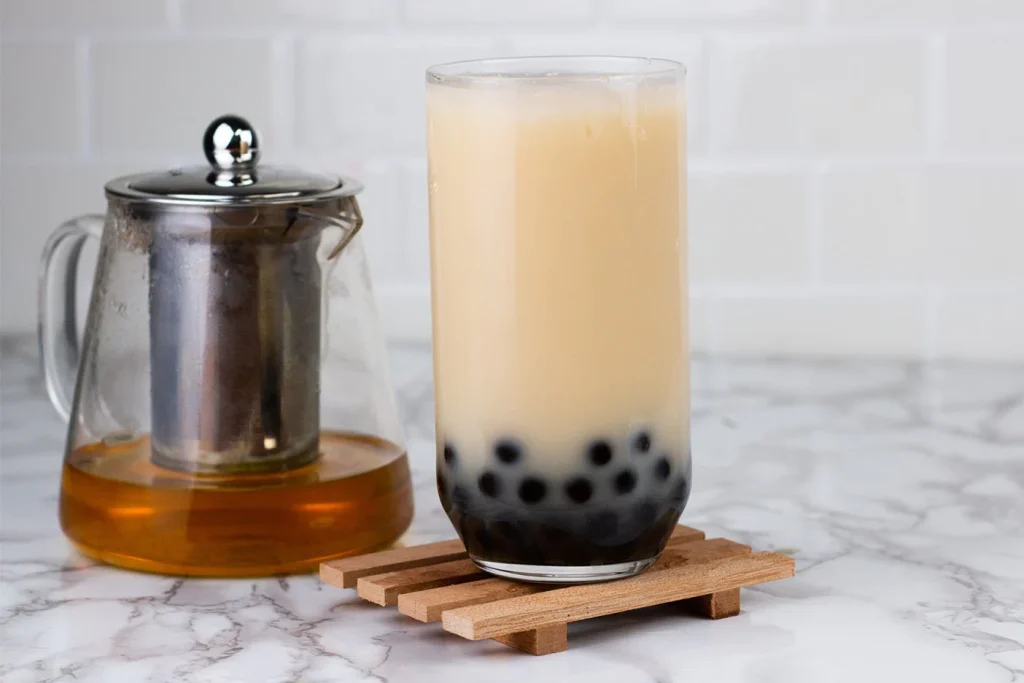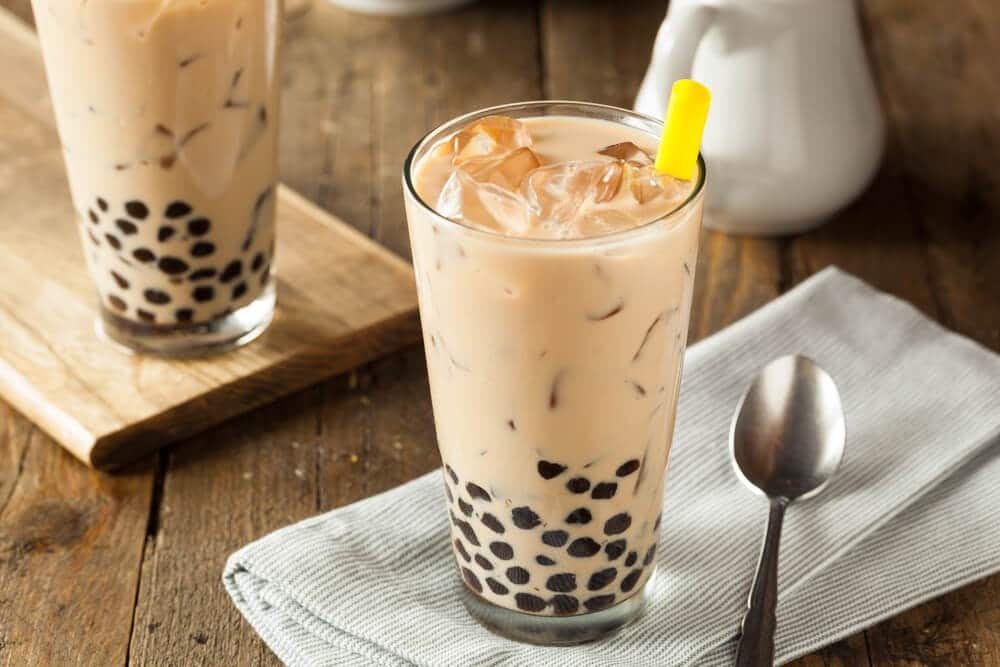The world of tea offers a myriad of flavors, from the robust kick of black teas to the gentle whispers of herbal infusions. Among these diverse flavors, there’s one drink that has captured the hearts (and palates) of millions globally: jasmine milk tea. Originating from the East, this fragrant and creamy beverage has made significant inroads into cafes and tea houses all over the world, establishing itself as a modern classic.
For the uninitiated, jasmine milk tea might sound like an intricate concoction, but in essence, it’s a harmonious blend of fragrant jasmine tea and creamy milk, often sweetened to perfection. The aroma alone – a delicate dance of floral notes from jasmine flowers intertwined with the warm and comforting scent of milk – promises a delightful sensory experience even before the first sip.
If you’ve never had the pleasure of tasting this enchanting drink, or are simply curious about what makes jasmine milk tea so beloved, you’re in for a treat. In this article, we’ll take you on a journey through the unique taste profile of jasmine milk tea, exploring its layers of flavor, its variations, and even how you can make your own at home.
So, whether you’re a seasoned tea aficionado or someone just beginning their tea adventure, buckle up and get ready to dive into the aromatic and delectable world of jasmine milk tea.
What Does Jasmine Milk Tea Taste Like?
Initial Sensory Experience
Upon being presented with a cup of jasmine milk tea, the first thing that strikes you is its enchanting hue – a creamy beige that seamlessly transitions from the deeper color of the tea to the milky white at the top, especially if not fully mixed. The consistency looks rich and smooth, with an inviting luster that suggests a drink that’s both refreshing and indulgent.
Recommended: What a Tea Bag Does In Warm Water Crosswood
Before you even take a sip, the aroma draws you in. The heady, fragrant scent of jasmine flowers wafts up, a natural and fresh aroma reminiscent of a blooming garden on a spring day. This floral scent mingles effortlessly with the underlying creaminess of the milk, creating a perfume that’s both calming and invigorating.
The First Sip
When the tea finally meets the palate, it’s a symphony of flavors. The floral notes from the jasmine present themselves first, delicate yet unmistakable, evoking images of jasmine vines under moonlight. Almost immediately after, the creamy and smooth texture of the milk envelops the tongue, acting as a counterbalance to the floral potency of the jasmine.
Depending on how it’s prepared, there’s a gentle sweetness that follows, either from sugar, honey, or other sweeteners. This sweetness doesn’t overpower but rather enhances the jasmine’s natural flavors, making the drink feel both comforting and luxurious.
Deep Dive into Flavor Profile
The jasmine in the tea offers a distinct floral essence, reminiscent of a gentle perfume. It has a light, airy quality, yet its flavor is pronounced and stays with you sip after sip. This delicate flavor can transport one to serene gardens, evoking feelings of peace and relaxation.
The milk serves as more than just a backdrop. It offers a richness and velvety texture that complements the jasmine’s fragility, ensuring the drink is neither too overpowering nor too light. The milk’s creaminess also provides depth to the beverage, making it filling and satisfying.
Often overlooked, the actual tea base – whether green or black – plays a crucial role. It provides the backbone for the jasmine and milk, grounding the drink and adding an additional layer of complexity. The tea’s inherent bitterness or astringency, albeit subtle, contrasts with the sweet and floral notes, creating a balanced and multi-dimensional flavor experience.
Texture and Mouthfeel
While flavor is paramount, the experience of drinking jasmine milk tea is also significantly influenced by its texture. The milk provides a smooth and creamy consistency, akin to a light latte or creamy coffee.
Recommended: Does Panera Green Tea Have Caffeine?
For many enthusiasts, the addition of tapioca pearls or boba adds a fun, chewy contrast, turning the drink into a delightful combination of textures that complement the interplay of flavors.

Jasmine Milk Tea Variations and How They Influence the Taste
1. Jasmine Green Milk Tea
This variation uses a green tea base infused with jasmine flowers. The inherent lightness and grassiness of green tea enhance the floral notes, resulting in a beverage that feels refreshing and invigorating. Jasmine green milk tea tends to be brighter and has a more pronounced jasmine flavor. The green tea adds a touch of vegetal undertone which complements the floral jasmine beautifully.
2. Jasmine Black Milk Tea
When black tea serves as the foundation, the resultant beverage is richer and deeper. Black tea’s robustness provides a stronger backdrop against which the jasmine’s subtlety can shine. This results in a more balanced interplay between the strong tannins of black tea and the fragrant notes of jasmine, offering a fuller-bodied experience.
Adjusting Sweetness Levels
The level of sweetness can significantly alter the jasmine milk tea experience. An unsweetened version allows the natural flavors of jasmine, tea, and milk to come forward uninhibited. On the other hand, a sweeter variant can feel more dessert-like and indulgent. Some prefer using traditional sugar, while others opt for honey, agave, or even brown sugar syrup, each adding its own unique flavor profile.
With or Without Boba
Tapioca pearls, commonly referred to as boba, add an entirely new dimension to the drink. Their chewy texture offers a delightful contrast to the smoothness of the tea. Furthermore, if they’re soaked in syrup or honey, they can add bursts of sweetness with each sip, making the drinking experience more interactive and playful.
Other Additions and Variations
- Jasmine Oolong Milk Tea: Using an oolong tea base, which sits between green and black tea in oxidation, brings forth a slightly fruity, floral, and creamy note, enriching the jasmine experience.
- Iced vs. Hot: The temperature at which you enjoy your jasmine milk tea can influence its taste. While iced jasmine milk tea feels more refreshing and is often favored during warmer months, hot jasmine milk tea can feel cozier and allows the drinker to better experience the aroma.
- Additional Toppings: Beyond boba, there are other popular additions like grass jelly, lychee jelly, or even whipped cream on top for an extra indulgent twist.
Recommended: Is Chai Tea Good For Sore Throat?
Understanding these variations can help you tailor your jasmine milk tea experience to your palate, whether you’re looking for something light and refreshing or a richer, deeper flavor.
Pairing Jasmine Milk Tea with Food
Pairing drinks with the right foods can elevate the overall tasting experience. Jasmine milk tea, with its intricate balance of floral notes, creamy texture, and underlying tea flavors, pairs exceptionally well with a range of snacks and meals.
Let’s explore some delightful pairings to complement and enhance the taste of this aromatic beverage:
Traditional Asian Snacks
- Dim Sum: The delicate flavors of har gow (shrimp dumplings) or siu mai (pork and shrimp dumplings) complement the floral notes of jasmine milk tea. The tea can act as a palate cleanser between bites.
- Mooncakes: Often consumed during the Mid-Autumn Festival, the sweet and dense nature of mooncakes can be balanced with a less-sweetened jasmine milk tea, ensuring the palate doesn’t feel overwhelmed.
- Rice Cakes: Whether sweet or savory, the soft, chewy texture of rice cakes offers a contrasting mouthfeel to the smoothness of the tea.
Desserts
- Pastries: Light pastries, like croissants or Danish pastries, harmonize with jasmine milk tea, as the buttery flavors mingle well with the creamy and floral notes of the tea.
- Macarons: The sweet and airy texture of macarons, especially floral variants like rose or lavender, can be a delightful companion to jasmine milk tea.
- Fruit Tarts: The tartness from fruits like berries or kiwi can be offset by the subtle sweetness and creaminess of the tea.
Western Snacks
- Sandwiches: Light sandwiches, especially those with chicken, turkey, or even cucumber, can be a great midday meal paired with iced jasmine milk tea.
- Salads: A fresh garden salad with a light vinaigrette dressing can be uplifted with a side of jasmine milk tea. The tea’s creaminess can complement the crunchy textures and fresh flavors of the salad.
- Cheese: Mild cheeses, such as brie or camembert, can be paired with hot jasmine milk tea for a cozy evening snack. The creamy nature of the cheese and the tea play off each other wonderfully.
Vegan and Gluten-Free Options
- Tofu Dishes: Silken tofu with a light soy or ginger sauce can be a fantastic pairing, as the tofu’s soft texture and the tea’s creaminess harmonize.
- Gluten-Free Pastries: Almond flour cookies or muffins can bring out the nutty undertones in the tea, making for a fulfilling snack without gluten.
Recommended: Does Drinking Milk Give You Man Boobs?
The art of pairing jasmine milk tea with food lies in balancing textures, flavors, and temperatures. Whether opting for traditional Asian delicacies or exploring more Western or dietary-specific options, the versatility of jasmine milk tea ensures that there’s a pairing for every palate and occasion.

Making Jasmine Milk Tea at Home
There’s something deeply satisfying about crafting your own cup of jasmine milk tea, allowing you to customize it to your precise taste. Plus, with the right ingredients on hand, it’s surprisingly simple!
Here’s a basic recipe, along with some tips to help you brew the perfect cup:
Basic Jasmine Milk Tea Recipe
Ingredients:
- 2 jasmine tea bags or 2 tablespoons of loose-leaf jasmine tea
- 1 cup of hot water (around 195°F or 90°C)
- 1-2 tablespoons of your preferred sweetener (sugar, honey, agave syrup, or brown sugar syrup)
- 1/4 cup of milk (whole milk, almond, soy, oat, or any other preference)
- Ice cubes (if you’re making it iced)
- Optional: Cooked tapioca pearls (boba) for that classic bubble tea experience
Instructions:
- Brewing the Tea: Begin by boiling water. Once boiled, let it cool slightly to reach the ideal temperature. Pour the hot water over your jasmine tea bags or loose leaves. Steep for 3-5 minutes, depending on your strength preference. Remove the tea bags or strain the loose leaves.
- Sweetening the Tea: While the tea is still warm, stir in your chosen sweetener. This ensures it dissolves properly. Adjust the amount based on your desired sweetness level.
- Adding Milk: Pour in your milk of choice. If you’re using non-dairy milk, ensure it’s one that doesn’t curdle easily with heat.
- Serving: For a hot jasmine milk tea, simply pour your mixture into a mug. For an iced version, fill a glass with ice cubes, then pour your tea mixture over the top.
- Add Boba (Optional): If you’re adding tapioca pearls, ensure they’re cooked according to their package instructions. Add them to the bottom of your glass before pouring the tea mixture.
Tips for the Perfect Homemade Jasmine Milk Tea
- Quality Matters: Investing in good quality jasmine tea can make a world of difference in flavor. Look for jasmine pearls or whole-leaf teas for a more authentic and aromatic experience.
- Temperature Check: Avoid pouring boiling water directly onto the tea, as it can scorch the leaves and result in a bitter taste.
- Customize: The beauty of homemade jasmine milk tea is in its adaptability. Play around with the milk-to-tea ratio, try different sweeteners, or add additional flavorings like vanilla or even a touch of lavender.
- Creamier Texture: If you’re looking for a creamier texture, you can use condensed milk or cream instead of regular milk. This will also add a richer sweetness to your tea.
- Cold Brew Option: For a smoother and more aromatic iced jasmine milk tea, consider cold brewing your jasmine tea overnight. This method extracts flavors gently, resulting in a tea that’s less astringent and more fragrant.
Recommended: What Does Castor Oil Do To Fibroids?
Armed with this guide, you’re now ready to embark on a delightful journey of crafting your own jasmine milk tea at home. Whether you stick to the basics or get experimental, there’s immense joy in sipping a cup you’ve made just to your liking. Enjoy!
Conclusion
Jasmine milk tea, with its poetic blend of aromatic floral notes and creamy richness, stands as a testament to the art of beverage crafting. Its popularity is well-earned, given its ability to transport drinkers to serene landscapes with just one sip.
As we’ve journeyed through its flavors, variations, pairings, and homemade crafting, it becomes clear why this drink holds a special place in the hearts of many.
Whether you’re a seasoned enthusiast or a curious first-timer, there’s always a new facet of jasmine milk tea waiting to be explored and savored. Happy sipping!
